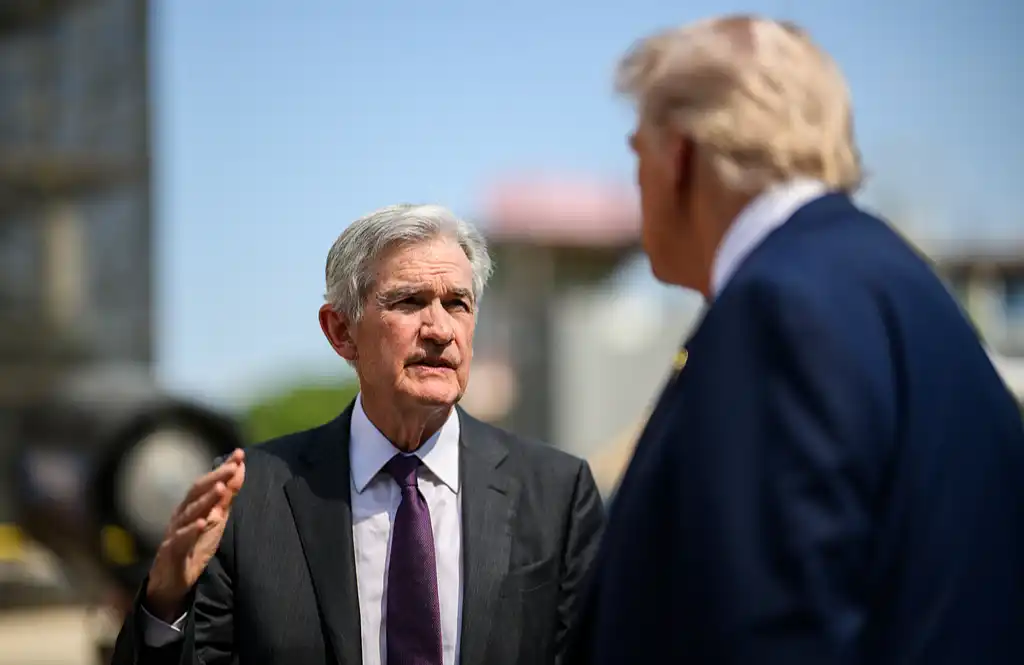Stablecoin Bill in Hand, Amid Restless Wall Street Bankers
The Stablecoin has "landed ashore," and the "ceiling" of U.S. Crypto Finance has been once again lifted.
Just last night, the U.S. House of Representatives officially passed the "GENIUS Act" and the "CLARITY Act," bringing a "shoreline formation" for Stablecoins in the race, setting a clear regulatory tone for the entire digital asset industry. The White House subsequently announced that Trump will personally sign the GENIUS Act this Friday. Henceforth, Stablecoins are no longer experimental products in a gray area but are about to be inscribed into U.S. law as a nationally endorsed "official currency tool."
Almost at the same time, the three major financial regulatory giants, the Fed, FDIC, and OCC, jointly issued guidance a few days ago, clearly stating that U.S. banks can provide cryptocurrency custody services to customers for the first time. Various banks and institutions on Wall Street can no longer hold back.
Traditional Banks Waving the Stablecoin Flag High
As the second-largest bank in the U.S., Bank of America (BoA) has officially confirmed that the bank has been actively preparing Stablecoin products and considering collaborating with other financial institutions to jointly launch them. They stated, "We are ready, but still awaiting further clarity from the market and regulators."
"We have done a lot of preparation." Bank of America CEO Brian Moynihan said they are currently deeply researching customer needs, will launch Stablecoin products at the appropriate time, and may partner with other financial institutions.
At the same time, Bank of America has also released an on-chain research weekly report called "On Chain," clearly focusing on Stablecoins, RWA, payment settlements, and infrastructure. The release of "On Chain" comes at a critical week in Washington as lawmakers are deliberating the GENIUS Act, CLARITY Act, and the Anti-Central Bank Digital Currency Surveillance Act, all of which could influence the U.S.'s policy direction regarding Stablecoins and digital infrastructure.

The research team pointed out, "Rather than hype, we focus on what can truly change the fundamental architecture of finance," and specifically mentioned that Ethereum is expected to play a key role in driving interoperability of digital assets. They even revealed that they are already piloting Stablecoin partnerships with mainstream retail platforms like Shopify, Coinbase, and Stripe, aiming to disrupt the old way of using Stablecoins and bring new business models.
"As long as the regulations are clear, banks are ready to accept cryptocurrency payments." Bank of America CEO Brian Moynihan stated.
Citigroup also has a "wait-and-see" attitude.
Citi CEO Jane Fraser explicitly stated that the bank is actively advancing its stablecoin-related plans and sees it as a key cornerstone of future international payments. Citi's bet on stablecoins reflects a rethink of global cross-border payments: high fees and slow settlement times. Currently, the hidden costs of cross-border transactions often reach as high as 7%, and existing interbank networks also fall short in terms of availability and efficiency compared to on-chain solutions. Citi's goal is to build a round-the-clock, programmable new payment rail with stablecoins, allowing corporate clients to transfer money worldwide at low cost and high efficiency.
Meanwhile, as an "old acquaintance" in the crypto world, JPMorgan Chase is moving faster.
On June 18, JPMorgan Chase announced the pilot launch of a deposit token named JPMD, deployed on the Base blockchain supported by Coinbase. Initially, this token is only available to JPMorgan Chase's institutional clients and will gradually expand to a broader user base and more currencies after regulatory approval in the United States.
This marks the first time a Wall Street giant has directly issued traditional bank deposits on-chain, signaling a key step in the deep integration of traditional finance with the decentralized world. JPMD is a "permissioned deposit token" that is pegged 1:1 to JPMorgan Chase's US dollar deposits, supports 24/7 real-time transfers, low transaction costs as low as $0.01, and enjoys traditional financial protections such as deposit insurance and interest.

Compared to existing stablecoins, JPMD has stronger regulatory compliance and endorsement of trust and is expected to bring unprecedented levels of capital and institutional liquidity to the Base chain. JPM Blockchain Lead Naveen Mallela stated, "This is not about embracing crypto; it's about redefining banking."
Looking at the entire US banking industry, the speed of stablecoin adoption and on-chain movement far exceeds the crypto community's most optimistic expectations. The real wave of financial change has arrived.
"Green Light On," Can Traditional Banks Buy Bitcoin Too?
"The green light is on, and traditional finance is quickly entering the field. The barriers between banks and cryptocurrency are crumbling. This is extremely beneficial for cryptocurrency."
As Profitz Academy's founder Merlijn mentioned, on July 14, the three major US banking regulators, the Federal Reserve, FDIC, and OCC, jointly issued a statement requiring banks to establish a comprehensive risk governance system in areas such as key management, asset screening, network security, audit supervision, third-party custody, and compliance risk control when providing related services.
Although no new regulations have been enacted, this guidance document has systematically clarified regulatory expectations for cryptocurrency custody services for the first time. Crypto finance is transitioning from a "gray experimental field" to a "regulatory track," and traditional finance is no longer standing idly by.

This signal quickly sparked market reactions. Wall Street giants have successively disclosed the latest progress in their stablecoin and other cryptocurrency businesses, attempting to seize the initiative in the new round of financial infrastructure reconstruction. Meanwhile, crypto-native institutions such as Circle and Ripple are also actively promoting compliance processes, aiming to solidify their market position as the global regulatory framework gradually takes shape.
This also means that the boundaries between future banks, crypto asset management, and trading platforms are beginning to blur. Traditional banks are even actively "seizing" market share from crypto asset management and trading platforms.
Traditional Banks Engage in Cryptocurrency Battle with Native Asset Management
On July 15, Standard Chartered Bank announced that it will provide its institutional clients with spot trading services for Bitcoin and Ethereum, making it the first global systemically important bank (G-SIB) to do so. The service was first launched in London, Hong Kong, and Frankfurt, initially covering Asia and Europe, with plans to achieve 24/5 uninterrupted trading, directly connecting to traditional foreign exchange platforms. Corporate clients and asset management companies no longer need to go through complex processes or jump through hoops to open accounts; they can directly buy and sell Bitcoin and Ethereum as easily as trading foreign exchange, with settlement and custody options available through either proprietary or third-party services.
In fact, Standard Chartered Bank had laid out its digital asset custody and trading services through Zodia Custody and Zodia Markets several years ago; this announcement is just a public declaration of their existing initiatives, opening up their full range of services. Rene Michau, Standard Chartered's Global Head of Digital Assets, made it clear: the spot crypto business will first introduce BTC and ETH, with plans to expand to more crypto products in the future, including forwards, structured products, and contracts with no principal delivery, mirroring the business lines of crypto exchanges.
Meanwhile, JPMorgan Chase, Bank of America, and others are also preparing to launch cryptocurrency custody and related services. What was once considered implausible has now become a reality. Twelve months ago, you might have doubted whether "JPMorgan Chase would custody Bitcoin," but now the only question remaining is "which bank will capture the largest share first."
Also worth noting are the "challenger banks," such as Revolut in London, which has relied heavily on cryptocurrency transactions for a significant portion of its revenue. Its long-term goal is to apply for a U.S. banking license and fully penetrate the mainstream financial ecosystem.
Peter Thiel's Ambition: Building a New Silicon Valley Bank
Aside from asset custody, seizing market share in cryptocurrency-native asset management and trading platforms, Wall Street's ambitious individuals have also found new entry points in account services and credit support.
Multiple mainstream financial media outlets have confirmed: Peter Thiel is partnering with tech moguls Palmer Luckey and Joe Lonsdale to launch a new bank called Erebor, and has officially applied to the Office of the Comptroller of the Currency (OCC) for a national bank charter. The target clients of this bank are aimed directly at cryptocurrency, AI, defense, and manufacturing startups that "mainstream banks are unwilling to serve," seeking to become an alternative to the Silicon Valley bank that collapsed.
The founders of this bank also exhibit a distinct "Silicon Valley political-capital crossover" feature: Peter Thiel (co-founder of PayPal and Palantir, leader of Founders Fund), Palmer Luckey (founder of Oculus, co-founder of Anduril), Joe Lonsdale (co-founder of Palantir, founder of 8VC). All three were significant political donors to Trump in the 2024 US presidential election and have close ties to the "GENIUS Act" currently being promoted in Congress.
According to the application Erebor submitted to the OCC, Founders Fund will participate as the primary capital supporter, with the three founders not being involved in day-to-day management, only intervening in governance structure in a directorial capacity. The bank's management team will be led by a former Circle advisor and the CEO of compliance software company Aer Compliance, aiming to clearly delineate the boundary between politics and operations, emphasizing the institutionalized financial institution positioning in its application.

Learning from the lessons of Silicon Valley Bank, Erebor expressly states that it will implement a 1:1 reserve requirement system and control the loan-to-deposit ratio to be below 50%, preempting maturity mismatches and credit expansion from the source. Its application documents indicate that stablecoin services are one of the bank's core businesses, planning to support custody, minting, and redemption of compliant stablecoins such as USDC, DAI, RLUSD, creating the "most regulatory-compliant stablecoin trading institution" to provide enterprises with legally compliant fiat on-off ramps and on-chain asset services.
Its customer profile is equally precise: targeting innovative enterprises such as virtual currency, artificial intelligence, defense technology, and high-end manufacturing deemed "high risk" by traditional banks, along with their employees and investors; it also serves "international clients"—those who find it difficult to access the US dollar financial system, rely on USD clearing, or wish to reduce cross-border transaction costs using stablecoins. Erebor plans to act as a "correspondent bank" by establishing a super interface connecting these enterprises to the dollar system.
Its business model also has a strong native encryption color: deposit and loan services are provided with Bitcoin and Ethereum as collateral assets, without touching traditional mortgages or car loans; at the same time, holding a small amount of BTC and ETH on the balance sheet for operational needs (such as paying gas fees), not engaging in speculative trading. It is worth noting that Erebor has also defined regulatory boundaries: it does not provide asset custody services requiring a trust license, only providing on-chain fund settlement, and does not directly hold user assets.
In short, this is an advanced version of a Silicon Valley bank, and under various crypto-friendly policies, Erebor is very likely to strive to become one of the first "dollar clearing banks" to custody mainstream stablecoins such as USDC and RLUSD with compliance identities, providing a federal clearing path for stablecoins.
Related reading: "Peter Thiel Personally ‘Holds A Gathering’ for Erebor, Aiming to be the ‘Alternative’ of Silicon Valley Bank"
National Bank Charter, the Future of Crypto Banking
Against the backdrop of the stablecoin legislation settling down and the green light hanging in Washington, everyone can see that the next Wall Street banker's race has quietly begun.
And the "National Trust Bank Charter" is an important checkpoint in this race. This is one of the "ceiling-level" licenses in the U.S. financial system, and it is the most practical path for all crypto assets, institutional custody, and stablecoin companies to enter the mainstream financial system.
The U.S. banking system is composed of three core federal charters: National Bank, Federal Savings Association (FSA), and National Trust Bank. The first two are traditional banks and savings associations with a long history, high licensing barriers, and outrageous thresholds. The National Trust Bank Charter, designed specifically for trust, custody, pension, and other businesses, coincides with the new players in the crypto community who want to comply with the regulations.
Its credibility is even higher than most people imagine. First of all, the National Trust Bank Charter is equivalent to a cross-state pass. Once this charter is obtained, business can be conducted in all 50 states of the U.S. without applying state by state. In addition, this charter allows licensed institutions to provide institutional-level asset custody, digital asset custody, corporate trust, pension management, and other diversified financial services to customers. Although it cannot accept retail deposits or issue loans, this is in perfect alignment with the "must-have" of the crypto custody side—what everyone wants is asset security, fiat custody, and a compliant and transparent title.
More importantly, this is a charter directly issued by the Office of the Comptroller of the Currency (OCC), which is a federal-level banking charter. With this charter, a crypto company can apply to access the Federal Reserve's payment and settlement system, greatly enhancing liquidity and settlement efficiency.
Anchorage Digital: The First Crypto Custodian Bank to Take the Plunge
The first mover in the industry to take the plunge into crypto asset management is Anchorage Digital.
Founded in 2017 and headquartered in California, Anchorage Digital is a technology-driven financial services company that focuses on "digital asset custody," providing secure and compliant digital asset storage and custody services specifically for institutional clients (such as funds, family offices, and trading platforms).
Prior to 2020, crypto asset companies could only legally conduct custody business through state-level trust charters (such as the New York BitLicense and the South Dakota Trust Charter), with significant limitations on business scope and reputation.
However, in 2020, the OCC saw the arrival of a "crypto-friendly" figure—former Coinbase executive Brian Brooks. Upon taking office, he clearly stated for the first time: innovative digital asset companies are welcome to apply for a federal bank charter. Seizing the opportunity, Anchorage promptly submitted its application, submitting dozens of documents and hundreds of pages detailing KYC/AML, compliance, technology risk management, and organizational structure. On January 13, 2021, the OCC announced its approval, and Anchorage Digital Bank National Association was officially launched—making it the first fully compliant digital asset national trust bank in the United States.
After becoming the first "federally chartered" crypto custodian bank in U.S. history, Anchorage Digital's status skyrocketed, being seen as an institutional custody service provider on Wall Street, providing digital asset custody for asset management institutions and consortia such as BlackRock and Cantor Fitzgerald.
Unfortunately, good times didn't last long as the regulatory landscape quickly shifted. With a change in leadership at the OCC and tightening regulations, new applications for digital asset trusts were essentially put on hold overnight. Anchorage found itself in a tough spot, with this track effectively "frozen" for over three years.
It wasn't until the Trump administration came into power, bringing a crypto-friendly stance, that Jonathan Gould, a cryptocurrency-friendly official, was appointed as the acting head of the OCC. He rolled back some of the Biden-era "banking guidance for the industry," providing a more favorable environment for the crypto industry.
And earlier this month, the newly appointed head of the OCC, Jonathan Gould, who previously served as the Chief Legal Officer of the blockchain infrastructure company Bitfury, with a deep understanding of business, legal matters, and regulations. His appointment has made the market acutely aware that the federal compliance window has once again slightly opened. Entrepreneurs, funds, and projects in the industry have already started to become restless, waiting for the new round of licensing.
The Ultimate Game, Access to the Federal Reserve Clearing System
For the crypto community, merely holding a "National Trust Bank Charter" is not impressive enough. What truly makes everyone envious is "access to the Federal Reserve Clearing System" — the legendary "Fed Master Account."
For the crypto industry, this is a bigger temptation.
Settling directly with the Fed, clearing, transferring, and depositing without relying on a third-party major bank. For crypto companies, once they obtain the status of a master account, placing stablecoin reserves directly in the central bank is equivalent to completely connecting to the U.S. financial infrastructure. They are no longer "foreigners" or "second-class citizens" but are the legitimate entities endorsed by the U.S. financial system.
Everyone in the industry understands that this is the true meaning of "going mainstream," transforming from being viewed by the banking system as a foreigner or second-class citizen to being recognized by the U.S. financial system as a legitimate entity. Therefore, crypto stars like Circle, Ripple, Anchorage, and Paxos are all simultaneously obtaining a federal trust bank charter while persistently pursuing approval for a master account.
However, because the Federal Reserve is concerned about the potential misuse of the "master account" by crypto companies, which could pose financial stability risks (such as a sudden massive liquidation of risk assets affecting system liquidity) and may also involve regulatory challenges such as money laundering, illegal fund flows, and technical security, so far, no pure crypto company has been approved for a Federal Reserve master account. Even Anchorage, the first to "break the ice," has obtained a federal trust bank charter but has not yet been granted a master account.
So who else is still striving for a bank charter?
In late June 2025, Circle took the lead by submitting materials to establish a new bank called First National Digital Currency Bank, N.A., in order to directly custody USDC reserves and provide institutional-grade custody services.
Shortly after, Ripple also announced in early July that they had submitted an application to the OCC, and at the same time, they applied for a Federal Reserve master account, aiming to directly place the reserves of their stablecoin RLUSD in the central bank system, demonstrating a very aggressive stance.
The well-established custody company BitGo is also not willing to fall behind and is awaiting OCC approval. According to publicly available information, BitGo is also one of the designated service providers for the "Trump USD1" reserve custody.
In addition to these three most representative players in the crypto "mainstream," Wise (formerly TransferWise) has also submitted a license application positioning itself as a non-depository trust bank. Tech-savvy newcomers like Erebor Bank have openly announced their intention to expand their services to include the new economic industries of AI, crypto, national defense, and more. The first-generation blockchain bank, First Blockchain Bank and Trust, made a brief attempt during the Biden era but later quietly withdrew due to tight regulatory scrutiny. It is rumored that Fidelity Digital Assets also has plans to submit an application, but this has not been officially confirmed.
If Circle, Ripple, and BitGo can obtain this license, they will be able to bypass state-level compliance, expand nationwide, and even potentially access the Federal Reserve's master account. Once achieved, the stablecoin's USD reserve could be placed in the central bank's vault, and their custody and clearing capabilities could directly compete with traditional Wall Street giants.
It seems that regulators have always had mixed feelings about crypto companies aspiring to become banks. On one hand, with changes in OCC personnel and a more crypto-friendly policy environment, crypto companies have indeed found an opportune "window." On the other hand, holding these licenses does not automatically grant full banking privileges, and they still cannot accept demand deposits or make loans.
A new window has opened, but the barrier to entry remains high. Who will be the first to knock on the Federal Reserve's door? This could be the most exciting showdown in the second half between Wall Street bankers and crypto giants, with the winner even potentially reshaping the financial landscape of the next decade.
For the crypto industry, as stablecoins officially come ashore and banks officially open their doors, the once parallel worlds of crypto and Wall Street are finally converging under regulatory scrutiny. Previously contentious crypto assets, scrutinized by regulators, banks, and capital markets, are now being embraced as "mainstream assets," entering the daily accounts of every American and the balance sheets of every global financial institution.
Welcome to join the official BlockBeats community:
Telegram Subscription Group: https://t.me/theblockbeats
Telegram Discussion Group: https://t.me/BlockBeats_App
Official Twitter Account: https://twitter.com/BlockBeatsAsia
 Forum
Forum

 Finance
Finance
 Specials
Specials
 On-chain Eco
On-chain Eco
 Entry
Entry
 Podcasts
Podcasts
 Activities
Activities
 OPRR
OPRR










